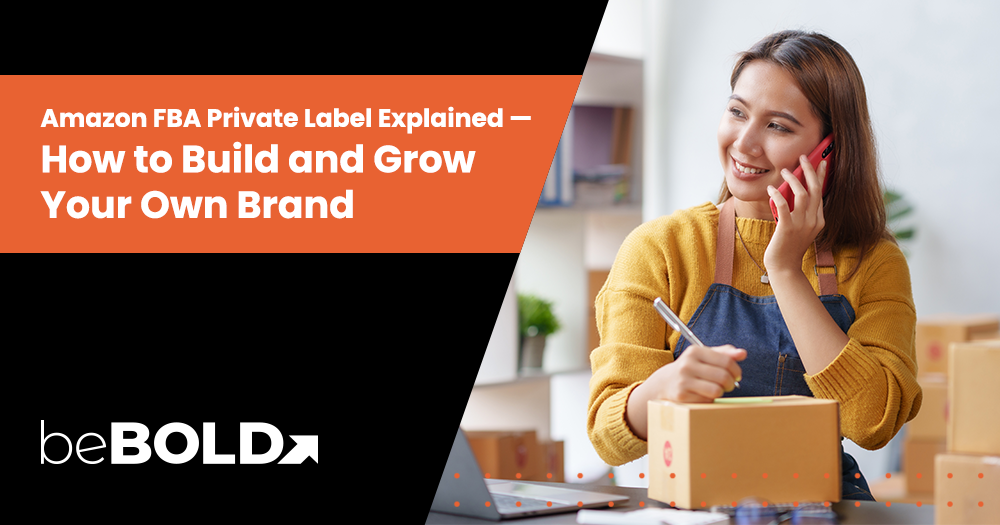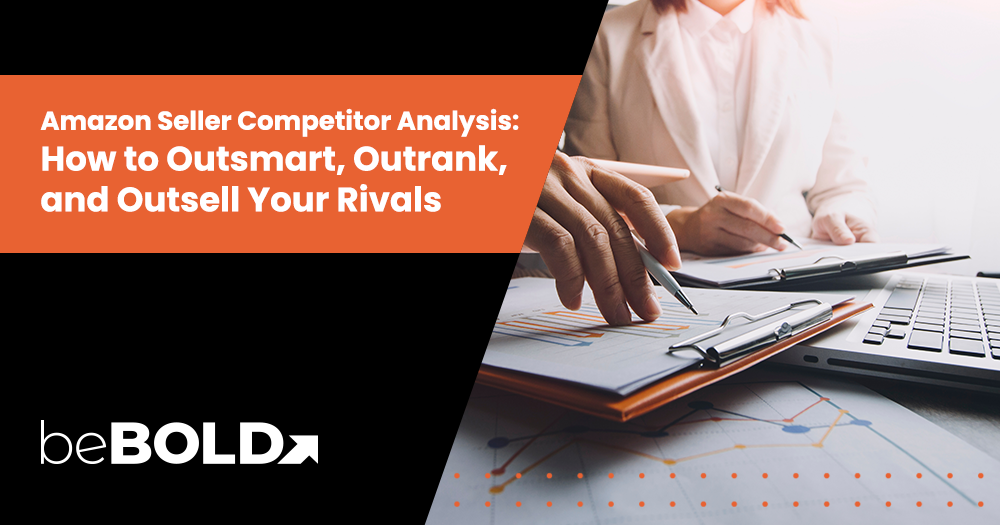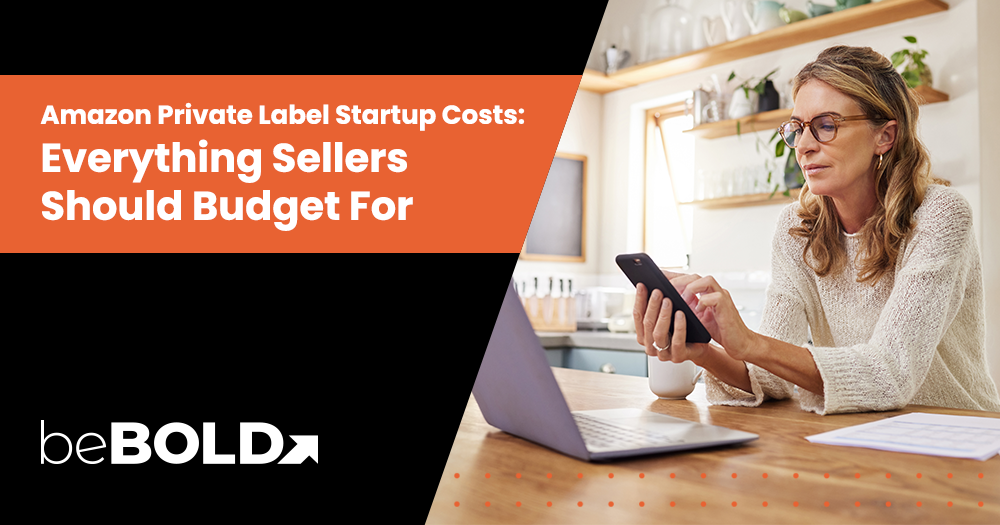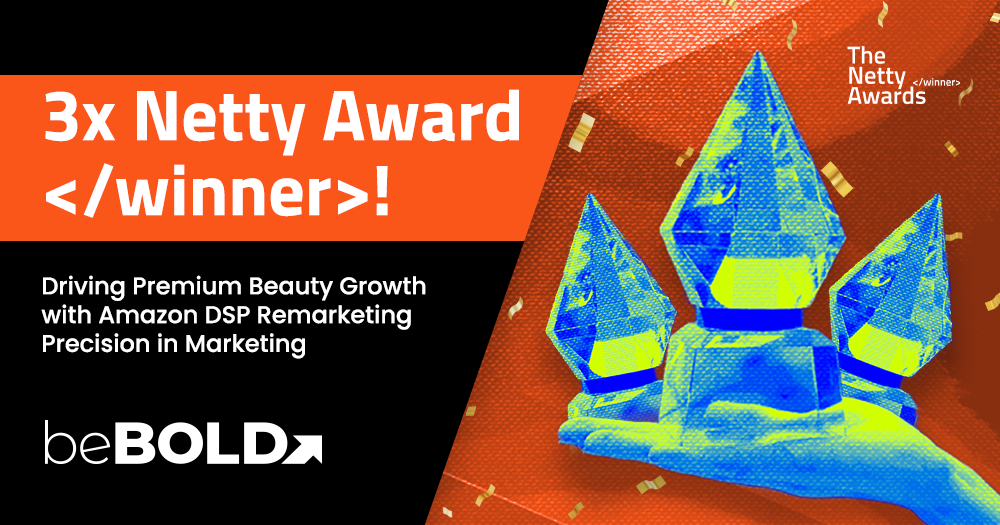Key Summary
- Build your own brand by sourcing from manufacturers, customizing products, and leveraging Amazon FBA for fulfillment. Sellers gain full control of pricing, packaging, and listings. 💼
- Success starts with data. Choose items with consistent demand, low review competition, and room for improvement. Research tools like Helium 10 or Jungle Scout help validate profitable niches. 📊
- Vet multiple manufacturers, test samples, and create consistent branding across product, packaging, and listings to earn buyer trust. beBOLD Digital recommends early trademark filing for Brand Registry. 🏷️
- Meet Amazon’s compliance standards, Professional Seller Account, verified business info, product testing, and packaging labels, to ensure seamless fulfillment. ✅
- Enjoy full ownership, scalable growth, and better profit margins while building a credible, long-term brand that demonstrates experience and expertise. 🚀
- Upfront investment, quality control, and operational complexity require transparency, proper planning, and a data-driven approach to maintain authority and trust. ⚙️
- Independent brands win by emphasizing story, quality, ethics, and authenticity, areas where Amazon’s in-house labels can’t easily compete. 🏆
What Are Amazon Private Label Products?
Private label means you source from a third-party manufacturer, then sell under your own brand on Amazon, often fulfilled by Amazon (FBA) for Prime shipping and customer service. This model gives you control over branding, pricing, packaging, and listing content. In fact, because this label offers greater flexibility and control over your branding, it is also one of the top seller strategies on Amazon, comprising 54% of sellers. In simple terms:
- Private Label = Your Brand, Not Amazon’s
- FBA = Amazon Handles Storage, Shipping, and Customer Service
At beBOLD Digital, we treat private labels like a brand business, not a listing trick. Start with a clear audience, brand promise, and a short list of proof-point differentiators you can show in images and A+ Content, such as ingredients, materials, usability.
How Do You Sell Private Label Products on Amazon?

Think of your launch in five stages: from idea to FBA shelf. Each stage should de-risk your next move.
- Pick your products
- Find an experienced supplier or manufacturer
- Build your brand
- Optimize your Amazon listing
- Choose fulfillment strategy
Pick Your Products
When zeroing in on potential profitable products to sell, look for steady demand and fixable pain points. Start with simple, small/light items, avoid complex compliance in your first SKU, and validate with measurable data, such as search volume, sales estimates, review depth. Mine 1- to 3-star reviews to spot opportunities to improve features or packaging.
What beBOLD Digital experts recommend: Target niches where demand is healthy but review moats are thin (e.g., top 10 competitors averaging manageable review counts). Prioritize beauty, home, and pet sub-niches with visible, image-led differentiation.
Find an Experienced Supplier or Manufacturer
Shortlist 2 to 3 factories or manufacturers from trusted sources. When you’ve chosen the best options, request samples, confirm MOQs/lead times, and review their QA processes. You can then start negotiating terms and payment, but keep a back-up supplier just in case.
What beBOLD Digital experts recommend: For overseas suppliers, require pre-shipment inspections and packaging tests that meet FBA standards to avoid check-in rejections.
Build Your Brand
For a casual browser to become a buyer, brands typically have less than a minute to convince them. According to a study on search behavior for conversion, “purchase probability reaches the highest when a person spends around 50 seconds on the item page.” And with the right branding, content and system, you can easily take advantage of these 50 seconds for better brand success. Consider creating memorable page content, including:
- Logo
- Product Design
- Packaging
- Products (line architecture)
Keep visuals consistent and customer-centric; use your brand story and value proposition to justify price.
What beBOLD Digital experts recommend: File your trademark and apply for Brand Registry early so you can unlock A+ Content, Brand Store, and brand protections. By doing this, you can easily protect your brand from counterfeits and have legal protection from day one.
Optimize Your Amazon Listing
Optimize your product listing by crafting a benefit-rich title, scannable bullets, and a persuasive description. Use professional hero and lifestyle images plus comparison/infographic frames. Just remember that you need to do keyword research before you write, not after.
What beBOLD Digital experts recommend: Build your media set around three angles: instant problem-solution proof; clear differentiation vs. alternatives; and trust cues, such as certifications, materials, results.
Choose Fulfillment Strategy
Decide between FBA (Prime badge, Amazon handles logistics/CS) and FBM/SFP (control, special handling). For most new private-label SKUs, FBA increases exposure and conversion.
Moving through these steps with discipline turns an idea into a Prime-eligible brand, not just a product.
Why You Should Sell Private Label Products

The upside is compelling, if you differentiate and execute with strategy, data, and long-term focus.
Benefits of Amazon Private Label Products
Full Brand Ownership
Owning a private label brand gives sellers complete control over positioning, pricing, and creative direction. Unlike resellers who compete for the Buy Box, you’re the only seller on your ASIN. This autonomy enables better storytelling, consistent branding, and improved profit margins over time. Having a clear brand identity shows experience and expertise in your product category: two signals shoppers value.
Better Long-Term Scalability
Private label products create a foundation for future growth. Once your brand earns trust, you can easily expand into variants, bundles, and complementary items. This shows authoritativeness by proving your brand understands customer needs and can evolve with them. Over time, a strong catalog also signals to Amazon that your brand provides depth and reliability in a niche.
Competitive Differentiation
The best private label products solve specific problems visible in competitor reviews. By addressing those pain points, you demonstrate first-hand experience with what customers care about. High-quality imagery and A+ content not only improve conversion rates on Amazon but also strengthen credibility signals that search engines and consumers look for: authentic, solution-oriented information backed by proof.
Stronger Marketing Opportunities
Owning your brand unlocks advanced marketing tools such as A+ Content, Brand Stores, and Sponsored Brands ads. These assets communicate your product story, demonstrate transparency, and build repeat traffic. These visual and informational touchpoints showcase expertise and trustworthiness through consistent, value-driven messaging.
Improved Customer Trust
Consistent packaging, visible certifications, and authentic social proof cultivate confidence. Buyers trust brands that provide clear, verifiable details, like tested materials or transparent sourcing. Reviews and Q&A responses further reinforce your brand’s trustworthiness by showing genuine interaction between your brand and real customers.
Control Over Reviews & Reputation
Private label sellers can actively manage feedback loops to identify recurring issues, improve products, and strengthen listings. This continuous optimization demonstrates a data-driven approach to quality.
beBOLD Digital experts suggest that sellers must treat reviews as an ongoing R&D channel. Every 10 to 15 reviews, audit customer feedback, refresh your images and bullets, and test improvements to the product itself.
A private label shines when your brand delivers authentic value, transparent communication, and continuous improvement. Brands that demonstrate genuine expertise and customer-centered innovation not only win Amazon rankings but also build long-term authority recognized by consumers.
Cons of Amazon Private Label
Know the trade-offs so you can plan cash flow and operations accordingly. While private labeling can yield long-term brand equity, it also demands discipline, capital, and credibility. Addressing these challenges with transparency and data-backed decision-making will help strengthen your brand’s profile and push better conversion rates.
- Heavy Upfront Capital Requirements: Launching a private label involves significant costs for minimum order quantities (MOQs), product molds, custom packaging, and paid marketing.
- Limited Oversight on Product Integrity: Working with third-party factories introduces quality control risks. Sellers must conduct inspections, require certifications, and maintain a transparent QA process.
- Operational Complexity and Ongoing Maintenance: Managing listings, ad spend, reviews, and inventory replenishment requires continuous learning and adjustment.
The “entry fee” for private label success is real, but predictable and surmountable with data-driven planning, transparent quality management, and consistent communication.
What Are Amazon FBA Private Label’s Requirements?
Before you list, make sure you tick Amazon’s compliance boxes. Amazon’s marketplace is tightly regulated, and missing even one requirement can lead to delays, suspensions, or removal of your listings. Every successful private label launch starts with understanding and meeting Amazon’s operational, branding, and compliance standards, from seller verification to proper labeling.
- Registered Amazon Seller Account: You must create a Professional Seller Account to access brand tools, advertising, and analytics. This ensures eligibility for FBA and large-volume listing capabilities.
- Business Verification: Amazon requires proof of your legal entity, tax identification, and contact details. This verification builds trust and prevents fraudulent selling activity.
- Product Compliance: Each category has its own rules for safety, labeling, and intellectual property. Products may require testing or certification, especially in beauty, health, or pet segments.
- Unique Branding: Your brand name should appear consistently on both the product and its packaging to meet Brand Registry requirements and improve customer recognition.
- Barcode/Identifiers: Every product needs a valid GS1 UPC, EAN, or GTIN, or an approved exemption, to generate an ASIN and track inventory accurately.
- FBA Packaging Standards: Products must meet Amazon’s prep and labeling guidelines, such as suffocation warnings, proper carton dimensions, and scannable labels, to avoid check‑in delays or rejections.
Bake compliance into your packaging spec sheet (labels, warning statements, inserts) and get a packaging sample approved before full production. Meeting these basics prevents costly check-in delays and listing blocks.
How Your Brand Can Compete with Amazon’s Private Label Brands
Amazon’s in-house labels compete on price and placement: your edge is story, quality, and speed to relevance.
Quick Comparison: Amazon’s Brands vs. Independent Brands
|
Dimension |
Amazon In-House Brands |
Independent Private Brands |
|
Primary Advantage |
Low prices; broad catalog |
Brand story; feature differentiation |
|
SERP & Exposure |
Often gain prime real estate in search/category |
Must win with SEO, images, reviews |
|
Consumer Trust |
Limited brand recognition beyond Amazon |
Can build distinct loyalty and social proof |
|
Go-to-Market |
Fast followers on best-sellers |
Can niche down and bundle/innovate |
Why this matters: Seller concerns about Amazon’s private labels are longstanding; competing means leading with brand, marketing, and service, not price.
Tactics to Stay Ahead
- Lead with differentiation customers value (materials, ethics, warranty, bundling).
- Invest in marketing & content (A+, Brand Store, comparison charts).
- Maintain fast, reliable fulfillment (FBA for Prime where feasible).
- Use variations & bundles to own more shelf space per click.
Common Mistakes to Avoid with Amazon Private Label Businesses

Source: Adobe Stock
Avoiding a few costly errors can save months and thousands of dollars.
- Violating Amazon policies: Breaking rules around reviews, claims, or compliance can result in account suspensions and permanent listing removals.
- Weak product research: Entering oversaturated markets or ignoring keyword and review data often leads to wasted inventory and low rankings.
- Poor supplier management: Skipping sample evaluations or quality checks risks defective shipments and bad reviews.
- Inventory mismanagement: Overstocking locks up capital, while stockouts tank rankings.
- Slow customer service: Ignoring messages or refund requests damages account health. Proactive, timely responses highlight authoritativeness and empathy.
- Hanging onto dead SKUs: Failing to liquidate unprofitable products drains resources. Making data-informed decisions about SKUs demonstrates accountability and business acumen.
To avoid these mistakes, beBOLD Digital recommends implementing a consistent operating cadence that proves both professionalism and transparency: weekly KPI tracking (rank, CTR, CVR, TACoS, OOS risk), monthly image and audit tests, and quarterly SKU reviews.
Process discipline beats guesswork. By documenting and refining your brand operations with honesty and data, you establish not just efficient systems but a foundation of credibility that positions your brand as an experienced and trustworthy authority.
Learn How to Build Your Private Label From the Ground Up With beBOLD Digital
A private label on Amazon is not a shortcut, it’s a system. When you validate demand, design a brand customers can see value in, and run operations with discipline, you build an asset, not just a listing. If you want expert help with product validation, Brand Registry setup, A+ content, and PPC/DSP launch, beBOLD Digital builds end-to-end roadmaps tailored to beauty, pet, and adjacent categories. beBOLD Digital can audit your category, shortlist lower-competition product angles, design conversion-first media, and run launch-to-scale PPC/DSP, so you can build a brand that lasts - Schedule a call with us today!
Frequently Asked Questions
How long does it take to launch a private label product on Amazon?
Typically 2 to 4 months from research to first sale, depending on supplier lead times and shipping; customs or production hiccups can add weeks. (Plan buffers.)
Can I start an Amazon private label with a small budget?
Yes, some start with ~$2,500–$5,000 by launching fewer units and ramping slower. More budget accelerates branding, inventory coverage, and ads.
Do I need to trademark my brand right away?
You can launch without it, but filing early unlocks Brand Registry (A+, Brand Store, Sponsored Brands/Display, and better protection).
How do I find reliable suppliers for private label products?
Use marketplaces (e.g., Alibaba/Global Sources), always request samples, verify certifications, and consider third-party inspections before mass production.
What are the risks of Amazon private label?
Oversaturated niches, upfront costs, QC failures, and slow review velocity—plus ongoing PPC and inventory management. A tight plan reduces exposure.
Can I switch from wholesale or arbitrage to private label?
Absolutely. Expect more capital and brand work, but higher control and margin potential.
What’s the difference between Amazon FBA private label and dropshipping?
Private label = you own the brand and (usually) inventory; FBA handles logistics. Dropshipping = you sell items you don’t stock; suppliers ship to buyers. Private label builds equity; dropshipping prioritizes speed and cash flow over control.










Comments